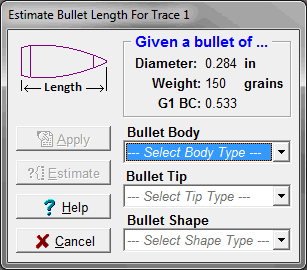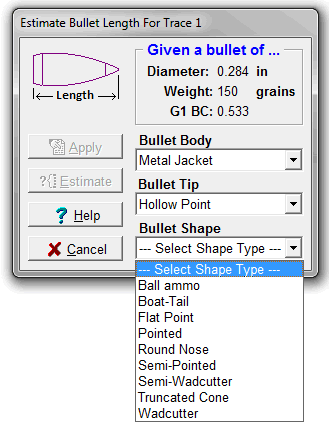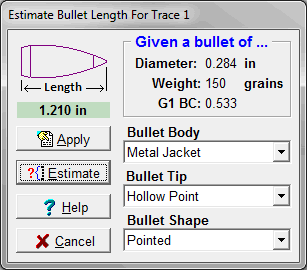|
Bullet Length Estimator To calculate spin drift and bullet stability it's necessary to know the bullet's length. While some bullet manufacturers now publish the lengths of currently produced bullets, not all of manufacturers do so, and there seems to be a complete lack of bullet length data for loaded ammunition. To fill that gap, Dexadine developed a bullet length estimator that's incorporated into the Ammo/Bullet library to automatically estimate bullet length if the actual value is not known. However, the bullet length estimator is also available from a Trace window by clicking on the units label (in/cm) just to the right of the Bullet Len parameter that's visible when Spin Drift is turned on. Running the bullet length estimator against a set of over 1,900 known bullets the estimated length is within 1/3 caliber of the bullet's actual length 92.5 percent of the time and within 1/4 caliber 86.4 percent of the time. As an example, for a 0.308 inch caliber bullet that means the estimated length was within 0.103 inches of the actual length 92.5 percent of the time and within 0.077 inches 86.4 percent of the time. No estimated length was more than a calber off. |
||
|
When the bullet length estimator opens it displays the given bullet diameter, weight and ballistic coefficient. These values are taken from the Trace window from which the bullet length estimator was opened. To estimate the length of a bullet, select the bullet body type, tip type, shape type from the drop down lists. |
 |
|
| Select the body type. The body type is the material the bullet is made out of. Copper Alloy includes brass, bronze, and gilding metal. Some bullets are constructed out of more than one material where there's sufficient quantities of both materials that the estimator needs to take that into account. That would include Copper with a lead or dense core, and Metal Jacket with partition. |  |
|
| Select the tip type. Hollow Point is not the same as Lead Tip HP, and selecting the wrong one reduces the accuracy of the estimate. If the bullet has an exposed lead tip and it's not solid select Lead Tip HP. If the bullet has something other than an exposed lead tip (copper, copper alloy, or metal jacket) and it's not solid select Hollow Point. Select Plastic Tip for all non-metallic tips, which are often called ballistic tips. |  |
|
| Select the shape type. This can be somewhat subjective as in the difference between Pointed and Semi-Pointed. Ball ammo is a term commonly applied to military or military type ammo, but its use in the estimator is specific to pistol ammo, either full metal jacket round nose or rounded tip hollow point designed for reliable feeding in automatic pistols. For rifle ammo use the actual shape such as Pointed. |  |
|
| With body, tip, and shape set, click the Estimate button to display the estimated length below the example bullet outline, or click the Apply button to calculate and apply the length to the Trace window's Bullet Len parameter. |  |
|